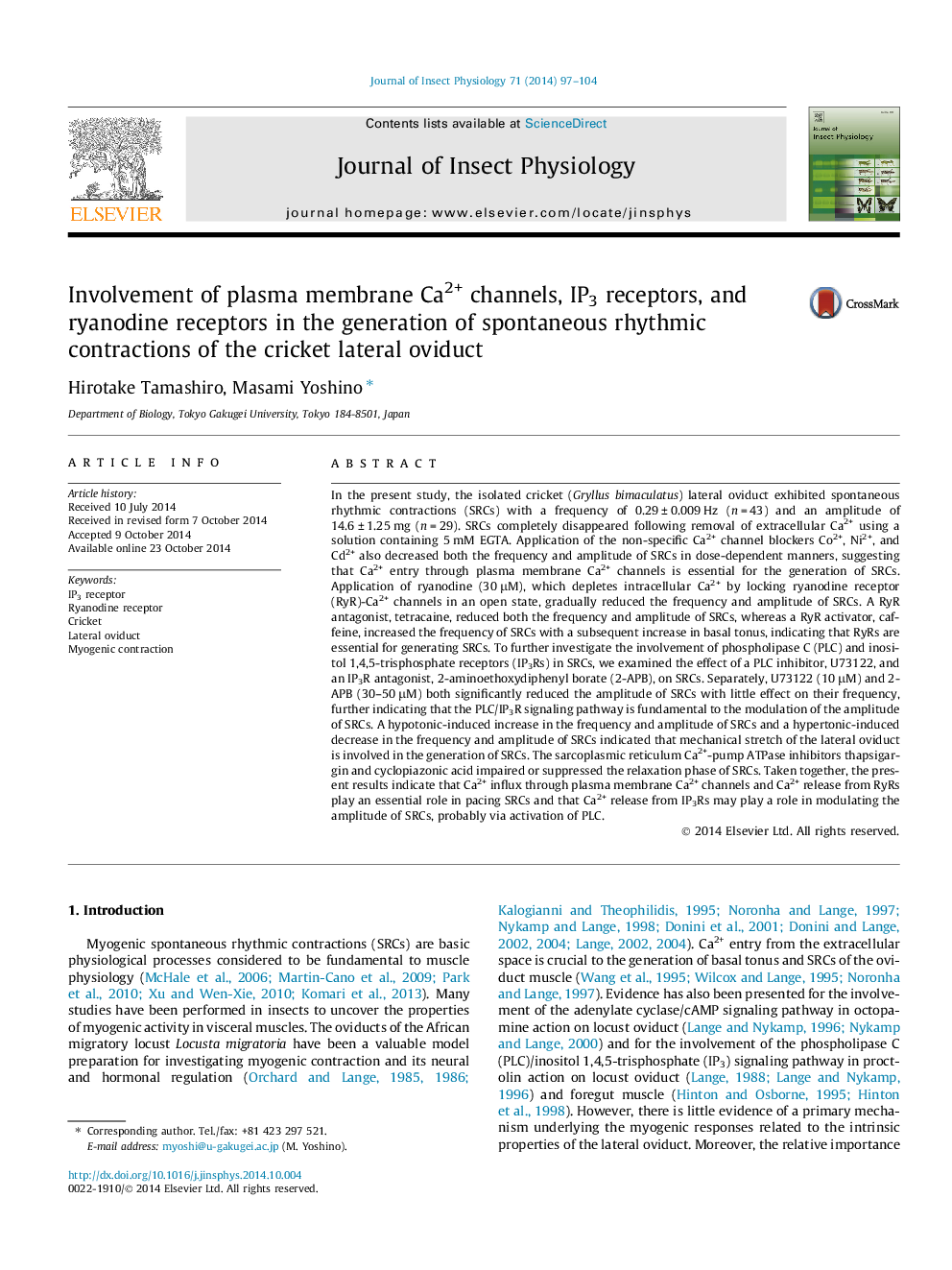| Article ID | Journal | Published Year | Pages | File Type |
|---|---|---|---|---|
| 5921563 | Journal of Insect Physiology | 2014 | 8 Pages |
â¢Cricket lateral oviduct shows myogenic spontaneous rhythmic contractions (SRCs).â¢Plasma membrane Ca2+ channels and ryanodine receptors play a role in pacing SRCs.â¢IP3 receptors play a role in modulation of the amplitude of SRCs.â¢Mechanical stretch of the lateral oviduct is involved in the generation of SRCs.
In the present study, the isolated cricket (Gryllus bimaculatus) lateral oviduct exhibited spontaneous rhythmic contractions (SRCs) with a frequency of 0.29 ± 0.009 Hz (n = 43) and an amplitude of 14.6 ± 1.25 mg (n = 29). SRCs completely disappeared following removal of extracellular Ca2+ using a solution containing 5 mM EGTA. Application of the non-specific Ca2+ channel blockers Co2+, Ni2+, and Cd2+ also decreased both the frequency and amplitude of SRCs in dose-dependent manners, suggesting that Ca2+ entry through plasma membrane Ca2+ channels is essential for the generation of SRCs. Application of ryanodine (30 μM), which depletes intracellular Ca2+ by locking ryanodine receptor (RyR)-Ca2+ channels in an open state, gradually reduced the frequency and amplitude of SRCs. A RyR antagonist, tetracaine, reduced both the frequency and amplitude of SRCs, whereas a RyR activator, caffeine, increased the frequency of SRCs with a subsequent increase in basal tonus, indicating that RyRs are essential for generating SRCs. To further investigate the involvement of phospholipase C (PLC) and inositol 1,4,5-trisphosphate receptors (IP3Rs) in SRCs, we examined the effect of a PLC inhibitor, U73122, and an IP3R antagonist, 2-aminoethoxydiphenyl borate (2-APB), on SRCs. Separately, U73122 (10 μM) and 2-APB (30-50 μM) both significantly reduced the amplitude of SRCs with little effect on their frequency, further indicating that the PLC/IP3R signaling pathway is fundamental to the modulation of the amplitude of SRCs. A hypotonic-induced increase in the frequency and amplitude of SRCs and a hypertonic-induced decrease in the frequency and amplitude of SRCs indicated that mechanical stretch of the lateral oviduct is involved in the generation of SRCs. The sarcoplasmic reticulum Ca2+-pump ATPase inhibitors thapsigargin and cyclopiazonic acid impaired or suppressed the relaxation phase of SRCs. Taken together, the present results indicate that Ca2+ influx through plasma membrane Ca2+ channels and Ca2+ release from RyRs play an essential role in pacing SRCs and that Ca2+ release from IP3Rs may play a role in modulating the amplitude of SRCs, probably via activation of PLC.
Graphical abstractDownload full-size image
